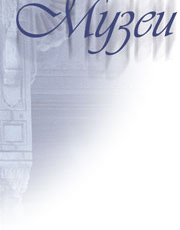
Burma
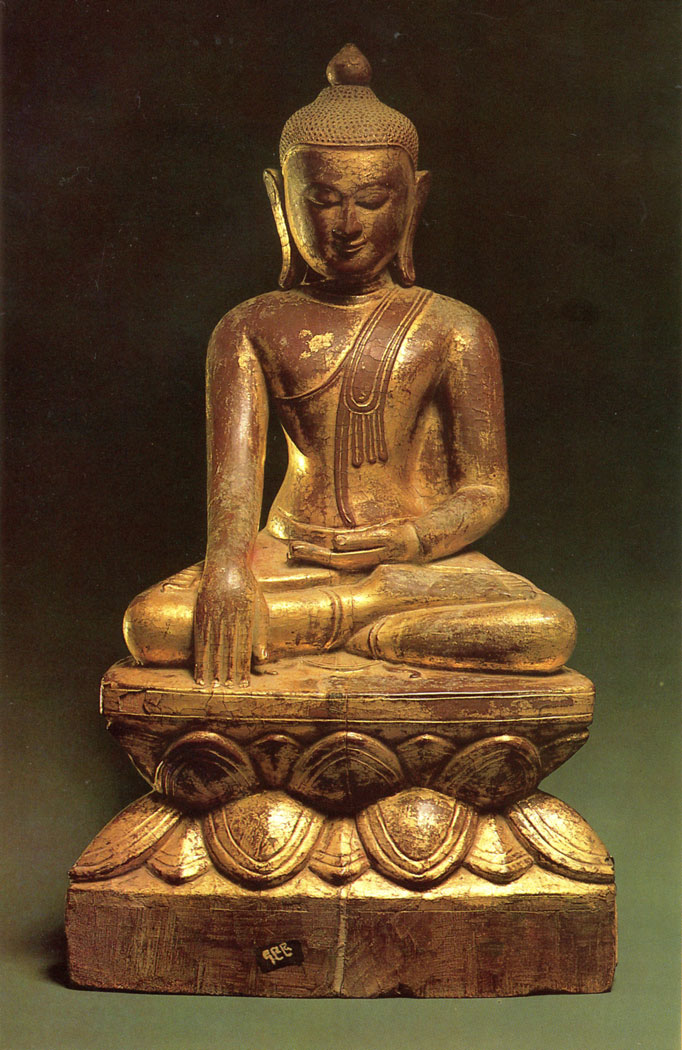
The Buddha
Mandalay, Burma. 19th century
Carved teak-wood; traces of gilt.
58 × 30 cm. Inv. No. 25220 КП
Received in 1976. First publication.
This statue is a fine example of Burmese wood-carving. This representation accurately follows the long-established canon, according to which all details of the Buddha's body are correlated with certain formulae of the Buddhist teaching and symbolize particular qualities and notions. This symbolic meaning is attached not only to the features of the Buddha's face, but also to his postures (asanas) and manual gestures (mudras). The posture represented here is called padmasana, or lotus-position (also yoga-position). It implies that the Buddha is in the state of meditation and controls all his emotions. This posture is a symbol of inner balance, absolute tranquillity and the victory of mental power over emotions.
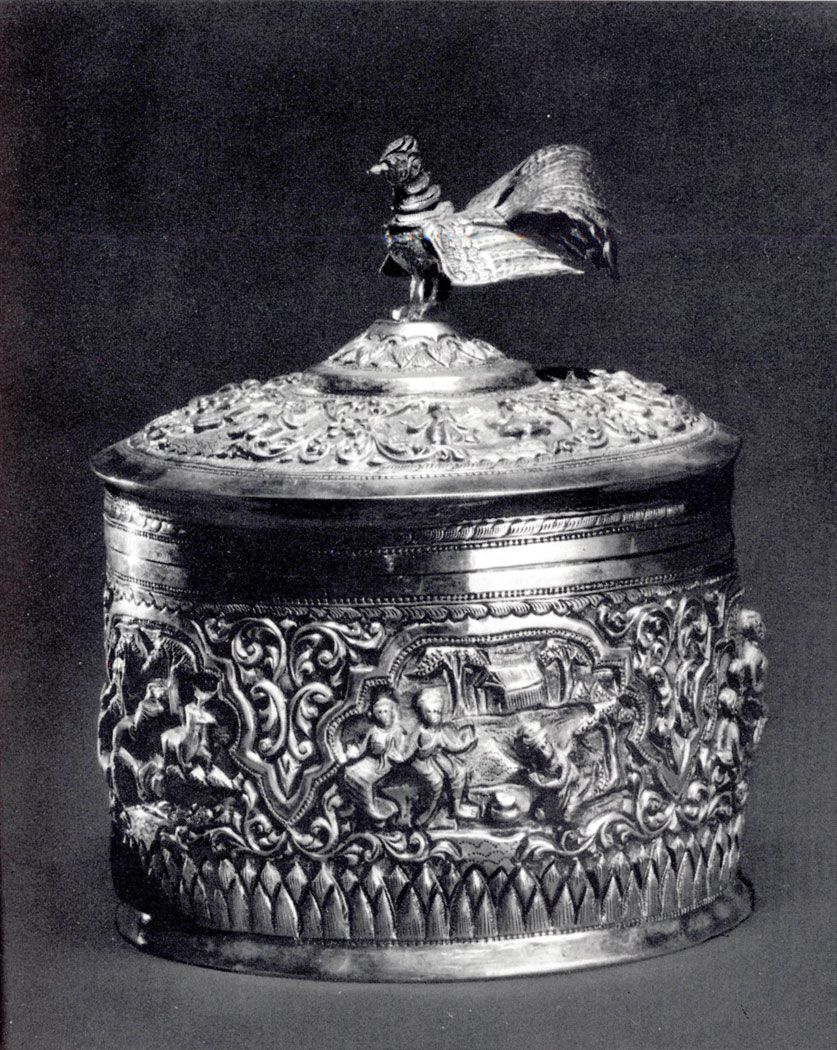
Box
Burma. 20th century
Chased silver.
Height 15 cm. Inv. No.4165 II
Received in 1958 as a gift from the Burmese Parliament. First publication.
This box is a fine example of traditional Burmese silverware. Burmese silver vessels are thin-sided and very light. Their decor is usually based on narrative and ornamental compositions in low relief. The principal part of the decor is a frieze-like pattern which features animals, human figures or many-figured scenes. Intricate floral designs form a picturesque framing for the figures. The main part of the decor is supplemented by several horizontal bands of floral ornamentation which alternate with the shining stripes of the smooth unpatterned silver surface. These decorative bands bring out the shape of the article as well as the supple plasticity of silver and its beautiful colour. The combination of the smooth shiny stripes and relief friezes creates a spectacular contrast of texture and colour which gives an additional jewel-like beauty to the article.
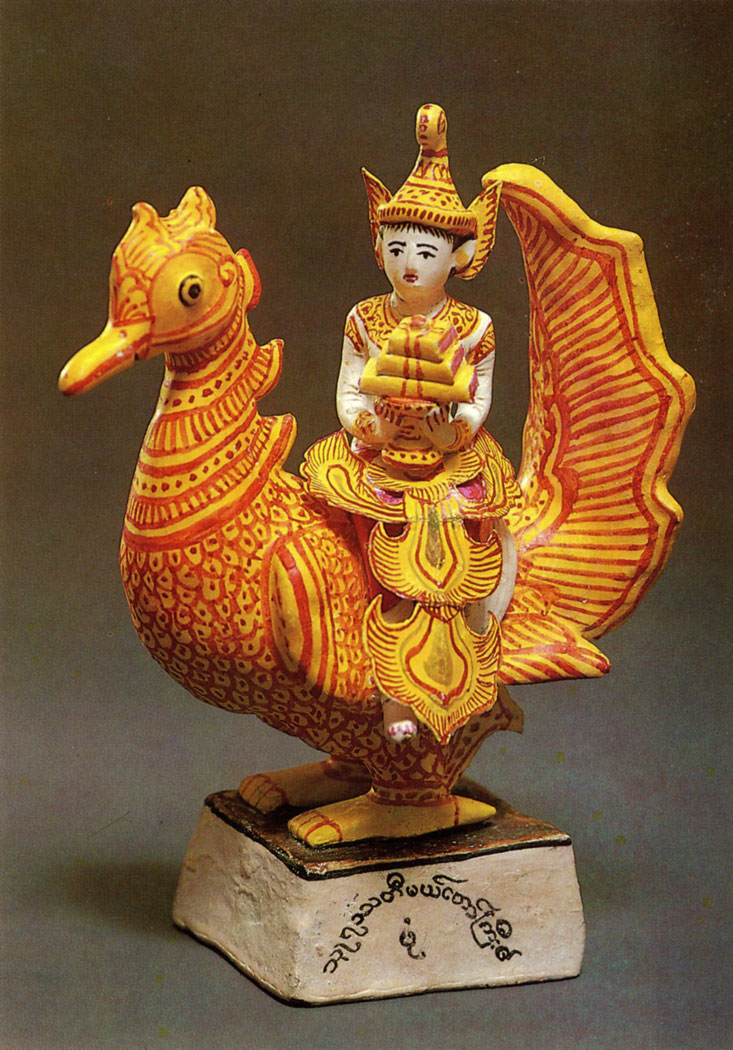
Thuyathadi
Burma. 20th century
Hand-worked clay and paper, whitewashed and painted in tempera.
Height 21 cm. Inv. No. 26367 КП
Received in 1973 as a gift from the Burmese government.
Thuyathadi, or Sarasvati, is a highly worshipped Burmese goddess, the patroness of literature, books, libraries and students. She is traditionally represented sitting on the back of Hintha, a mythical sacred bird, and with a pile of books in her hands. The figurine is made of non-fired clay (some details of the costume and headdress are made of thick paper), whitewashed and painted in tempera. The origin of this craft goes back into distant past, to the time of the ancient animist beliefs of the Burmese. The images oinats-the spirits who were believed to inhabit the world and personify various natural powers and creatures-were at that time hand-modelled in non-fired clay and brightly coloured. The same method was later used for making manyfigured compositions illustrating Buddhist and folk legends.
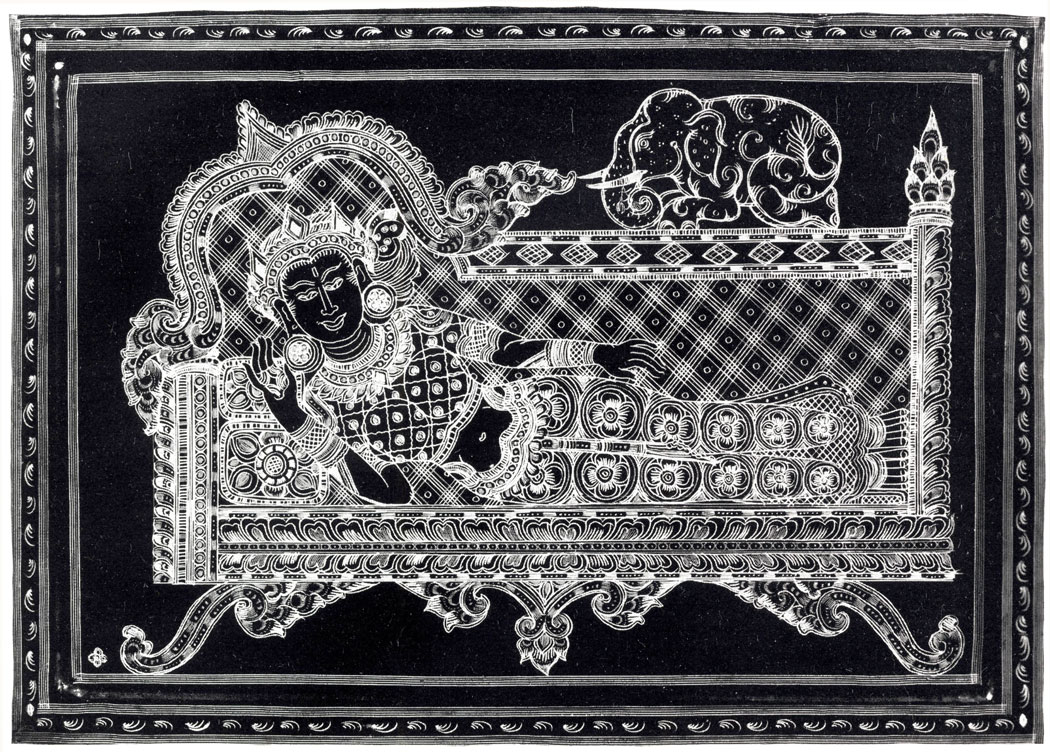
Panel: Dream of Maya, the Mother of the Buddha
Pagan, Burma. 20th century
Wood, lacquered and engraved.
43 x 30.5 cm. Inv. No. 26527
Received in 1973 as a gift from the Burmese government.
The composition is concerned with a traditional subject and illustrates the Buddhist legend according to which the mother of the Buddha had a prophetic dream: a white elephant descended from the skies and entered her body through her right hip-and that was how the Buddha was conceived. This subject was very popular in medieval Burmese art and in the course of time acquired a firmly established iconography which, incidentally, is fairly accurately shown in this panel.
The decor is incised on the wooden surface of the plate with a sharp instrument, and then incised contours are filled with various pigments mixed with lacquer.
The ornamentation of articles produced in this technique is characterized by visual decorativeness and a deliberate neglect of the laws of perspective. The style is very similar to that of medieval Burmese mural paintings. This is an example of how national artistic traditions are carefully preserved and developed by contemporary masters of lacquer miniature.
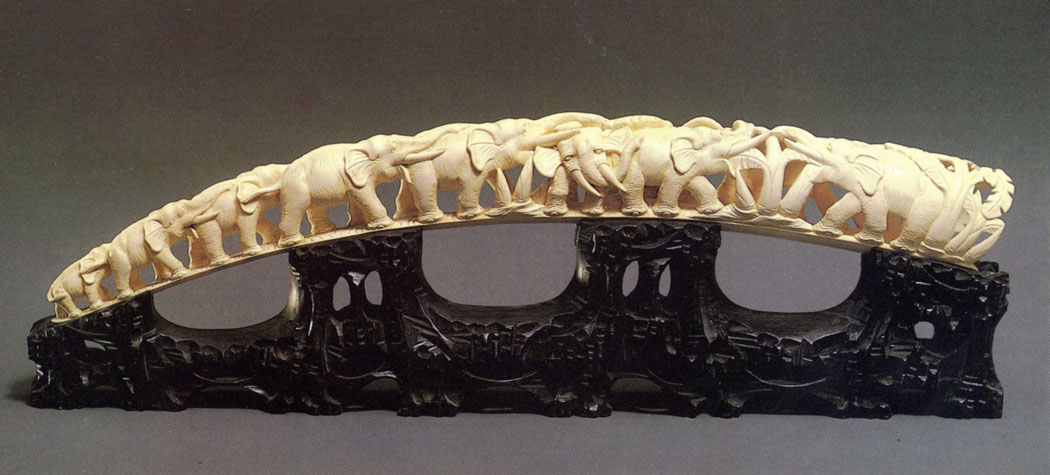
Procession of Elephants
Burma. Mid-19th century
Carved ivory.
Height 17 cm, length 66 cm. lnv. No. 4230 II
Received in 1961 from the Board of Art Exhibitions and Panoramas attached to the USSR Ministry of Culture, Moscow.
Ivory-carving is one of the oldest Burmese crafts. The composition reproduced here is carved of a whole tusk and designed as a table ornament representing a ceremonial procession of elephants across a humpback bridge.
The craftsman succeeded in finding an ideal compositional solution in which the design of the ornament and the original shape and size of the tusk are in perfect agreement. As a result, the article is striking for its monolithic compactness and expressive decorativeness.
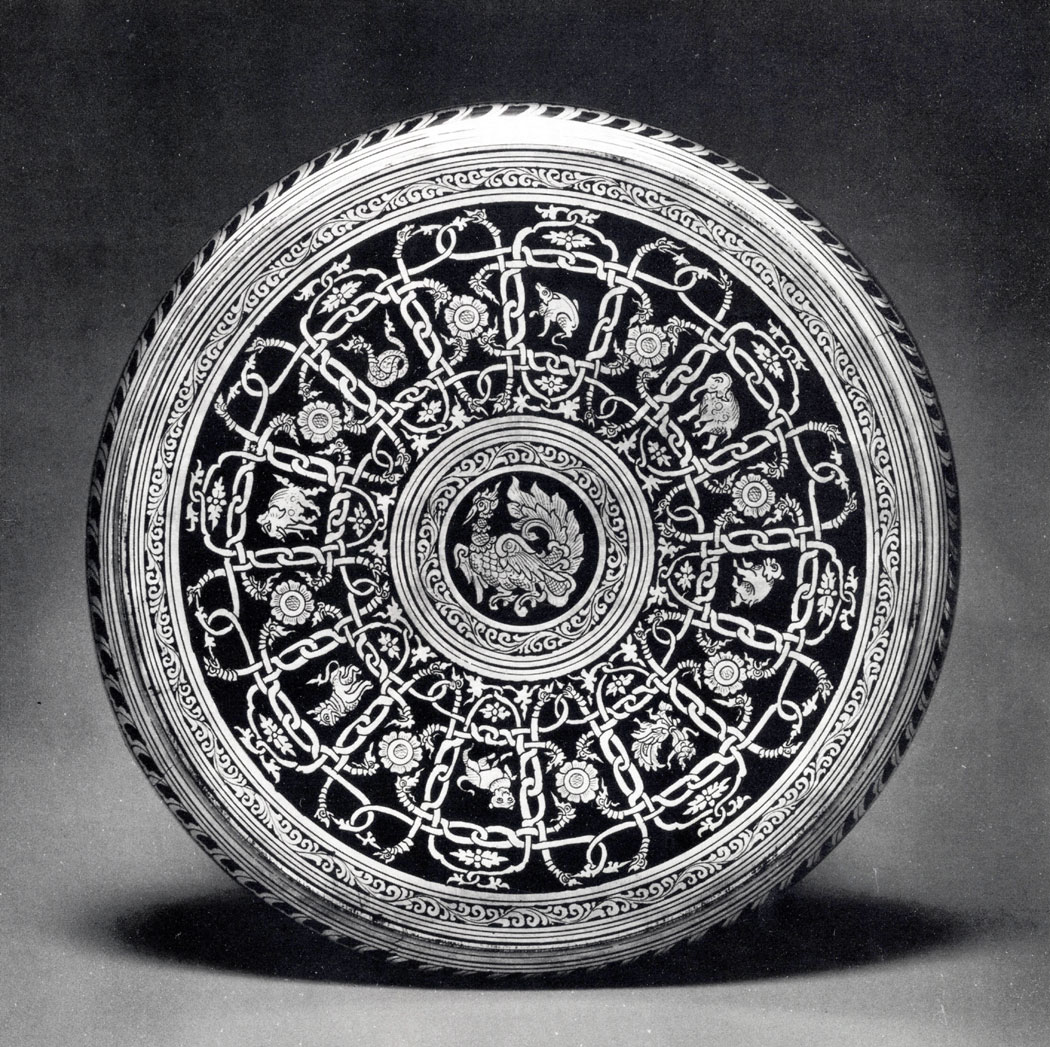
Table top
Burma. 20th century
Carved wood, lacquered and decorated with gold leaf.
Diameter 31 cm. Inv. No. 26523
Received in 1973 as a gift from the Burmese government.
Lacquer wares are a traditional Burmese type of luxury article. The technique used in making them consists in pasting gold-leaf patterns onto the black lacquer surface of the object. The refined gold design shining brightly against a black background produces a striking visual effect.
The table top shown here is decorated with an elaborate pattern incorporating planetary symbols. These symbols go back to the ancient cult of the planets whose vestiges survive even in present-day Burmese ornamentation.
Thus a pattern which is now treated merely as a decorative composition is a reflection of ancient cosmic beliefs and religious practices which have their origin in pre-historic times.
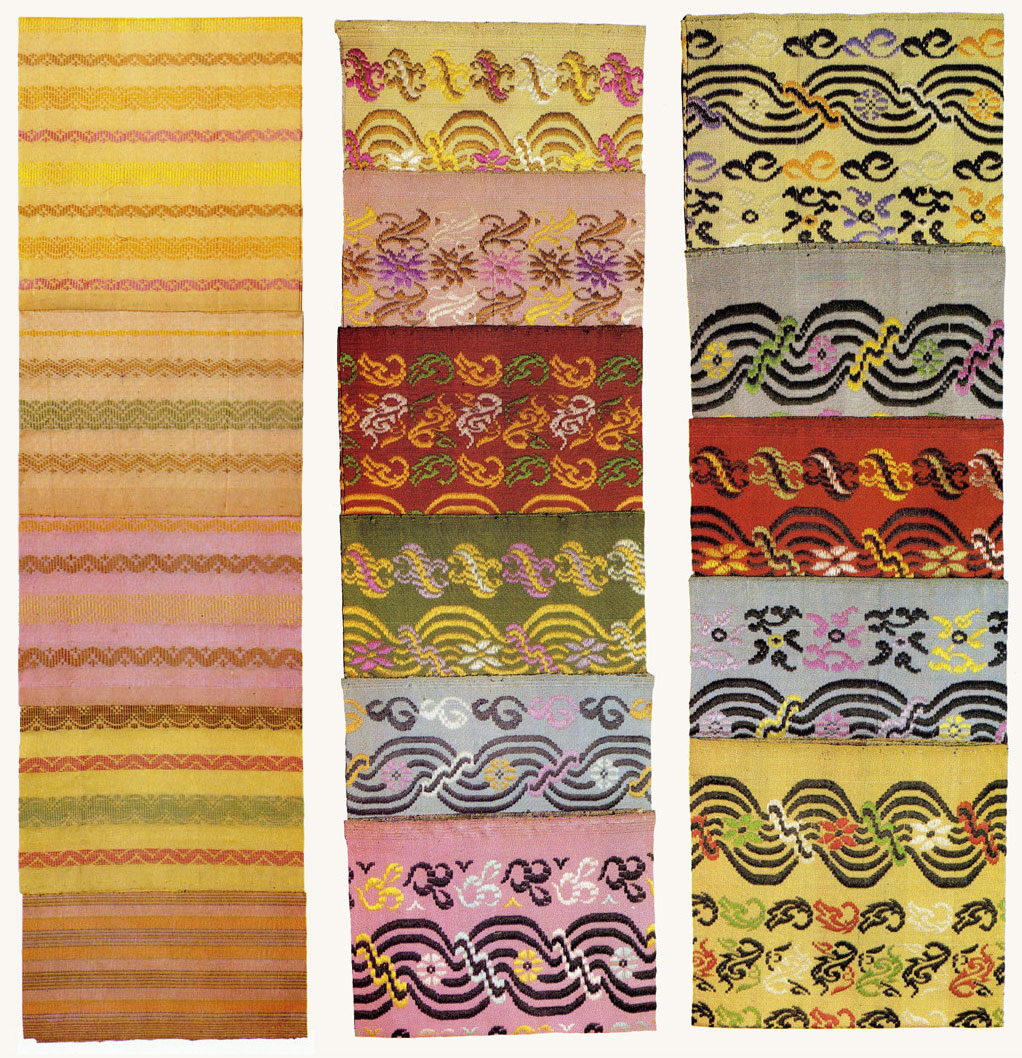
Samples of fabrics
Burma. 20th century
Hand-woven cotton and silk.
65 × 20 cm. Inv. Nos. 26343(1) -26348(2,3)
Received in 1973 as a gift from the Burmese government. First publication.
Burmese hand-weaving is a time-honoured craft based on well-established traditions and highly developed technique. In terms of their decor hand-woven fabrics fall into two large groups-those designed for men's and women's clothes respectively. Men's skirts were made of checked fabrics or fabrics with simple small-scale geometric patterns. Sometimes they were made of unpatterned silk. The colour range of men's costumes was usually rather restrained, and the ornamentation simple and unpretentious. Women's skirts, on the contrary, required bright polychrome fabrics decorated with all imaginable kinds of woven or embroidered designs. The largest centres of hand-weaving in Burma are Rangoon, Mandalay and Pakokku.
|
ПОИСК:
|
© MUSEUMS.ARTYX.RU, 2001-2021
При использовании материалов сайта активная ссылка обязательна:
http://museums.artyx.ru/ 'Музеи мира'
При использовании материалов сайта активная ссылка обязательна:
http://museums.artyx.ru/ 'Музеи мира'